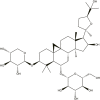Fufang shenhua tablet, astragali radix and its active component astragaloside IV: Research progress on anti-inflammatory and immunomodulatory mechanisms in the kidney
- PMID: 37089929
- PMCID: PMC10113559
- DOI: 10.3389/fphar.2023.1131635
Fufang shenhua tablet, astragali radix and its active component astragaloside IV: Research progress on anti-inflammatory and immunomodulatory mechanisms in the kidney
Abstract
Background: Given the limited treatment options available for kidney disease, a significant number of patients turn to alternative therapies, including traditional Chinese medicine. Among these therapies, the Fufang Shenhua tablet (SHT) has garnered attention for its effectiveness in addressing the most common deficiency of Qi and Yin in chronic glomerulonephritis. Notably, the sovereign drug of SHT is Astragali Radix (AR), with the most abundant and effective component being Astragaloside IV (AS-IV). AS-IV has been shown to possess anti-inflammatory and immunomodulatory properties, and it is extensively used in treating kidney diseases. Nevertheless, the molecular mechanisms underlying its action are numerous and intricate, and a comprehensive understanding is yet to be achieved. Aim of the review: Thus, we have thoroughly examined the existing research and outlined the advancements made in investigating the anti-inflammatory and immunomodulatory mechanisms of SHT, AR and its active component AS-IV, in relation to kidney health. This serves as a dependable foundation for conducting more comprehensive investigations, evaluating efficacy, and making further improvements in the future. Materials and methods: We conducted a comprehensive literature search utilizing multiple globally recognized databases, including Web of Science, Google Scholar, PubMed, ScienceDirect, Wiley, ACS, Springer, and CNKI. The search keywords used in this study were "Fufang Shenhua tablet," "Astragali Radix," "Astragaloside IV," and "Anti-inflammatory" or "Immunity." Results: The mechanism of inflammation inhibition by SHT, AR and its active component AS-IV is mainly related to the signaling pathways such as NF-κB, TLRs, PI3K/AKT, Wnt/β-catenin, and JAK-STAT. Immunomodulation exerts not only activating, stimulating, and regulating effects on macrophages and dendritic cells, but also on immune organs, T-lymphocytes, B-lymphocytes, and a myriad of cytokines. Moreover, the SHT, AR and its active component AS-IV also demonstrate regulatory effects on renal cells, including glomerular mesangial cells, tubular epithelial cells, and podocytes. Conclusion: To summarize, SHT, AR and its active component AS-IV, exhibit notable therapeutic effects in kidney-related ailments, and their molecular mechanisms for anti-inflammatory and immunomodulatory effects have been extensively explored. However, further standard clinical trials are necessary to evaluate their safety and efficacy in the adjunctive treatment of kidney-related diseases. Moreover, in-depth studies of unverified chemical components and regulatory mechanisms in SHT are required. It is our belief that with continued research, SHT, AR and its active component AS-IV are poised to pave the way for enhancing therapeutic outcomes in kidney-related ailments.
Keywords: Astragali Radix; Astragaloside IV (AS-IV); Fufang Shenhua Tablet; anti-inflammatory; immunity; kidney disease.
Copyright © 2023 Li, Shi, Wei, Wang, Du, Hong and Chen.
Conflict of interest statement
The authors declare that the research was conducted in the absence of any commercial or financial relationships that could be construed as a potential conflict of interest.
Figures





Similar articles
-
Fufang Shenhua tablet inhibits renal fibrosis by inhibiting PI3K/AKT.Phytomedicine. 2023 Jul 25;116:154873. doi: 10.1016/j.phymed.2023.154873. Epub 2023 May 13. Phytomedicine. 2023. PMID: 37257328
-
Spatially resolved multi-omics reveals the renal cortex-metabolic reprogramming of Shenhua Tablet for intervention on IgA nephropathy.Phytomedicine. 2025 Jun;141:156742. doi: 10.1016/j.phymed.2025.156742. Epub 2025 Apr 14. Phytomedicine. 2025. PMID: 40233505
-
Pharmacological potential of Astragali Radix for the treatment of kidney diseases.Phytomedicine. 2024 Jan;123:155196. doi: 10.1016/j.phymed.2023.155196. Epub 2023 Nov 7. Phytomedicine. 2024. PMID: 37952410
-
Biological active ingredients of Astragali Radix and its mechanisms in treating cardiovascular and cerebrovascular diseases.Phytomedicine. 2022 Apr;98:153918. doi: 10.1016/j.phymed.2021.153918. Epub 2022 Jan 8. Phytomedicine. 2022. PMID: 35104756 Review.
-
Astragali Radix (Huangqi): A promising edible immunomodulatory herbal medicine.J Ethnopharmacol. 2020 Aug 10;258:112895. doi: 10.1016/j.jep.2020.112895. Epub 2020 Apr 21. J Ethnopharmacol. 2020. PMID: 32330511 Review.
Cited by
-
Exploring the mechanism of Shenhua tablet alleviating renal injury by regulating macrophage glycolysis hypoxia-inducible factor-1α/ pyruvate kinase M2 signaling pathway in diabetic kidney disease mice.J Tradit Chin Med. 2025 Jun;45(3):528-537. doi: 10.19852/j.cnki.jtcm.2025.03.009. J Tradit Chin Med. 2025. PMID: 40524292 Free PMC article.
-
A tumor targeted nano micelle carrying astragaloside IV for combination treatment of bladder cancer.Sci Rep. 2024 Jul 31;14(1):17704. doi: 10.1038/s41598-024-66010-3. Sci Rep. 2024. PMID: 39085255 Free PMC article.
-
Astragaloside Ⅳ mediates the effect and mechanism of KPNB1 on biological behavior and tumor growth in prostate cancer.Heliyon. 2024 Jun 28;10(13):e33904. doi: 10.1016/j.heliyon.2024.e33904. eCollection 2024 Jul 15. Heliyon. 2024. PMID: 39027542 Free PMC article.
-
Yishen paidu pills attenuates 5/6 nephrectomy induced kidney disease via inhibiting the PI3K/AKT/mTOR signaling pathway.Front Pharmacol. 2024 Nov 28;15:1510098. doi: 10.3389/fphar.2024.1510098. eCollection 2024. Front Pharmacol. 2024. PMID: 39669205 Free PMC article.
-
Nutritional, Chemical, Antioxidant and Antibacterial Screening of Astragalus cicer L. and Astragalus glycyphyllos L. Different Morphological Parts.Foods. 2025 Jan 14;14(2):250. doi: 10.3390/foods14020250. Foods. 2025. PMID: 39856916 Free PMC article.
References
-
- Cen J., Jiang L., Wang H., Qi Y. (2016). Effect of Astragalus injection on the efficacy of chronic kidney disease and vascular endothelial growth factor and its soluble receptor. Chin. J. Integr. Traditional West. Nephrol. 17, 993–995.
-
- Chen W., Xie L. (2019). Astragalus polysaccharides alleviate inflammation in renal tubular epithelial cells after hypoxia reoxygenation by inhibiting p38MAPK signaling pathway. Immunol. J. 35, 593–598.
Publication types
LinkOut - more resources
Full Text Sources
Research Materials

